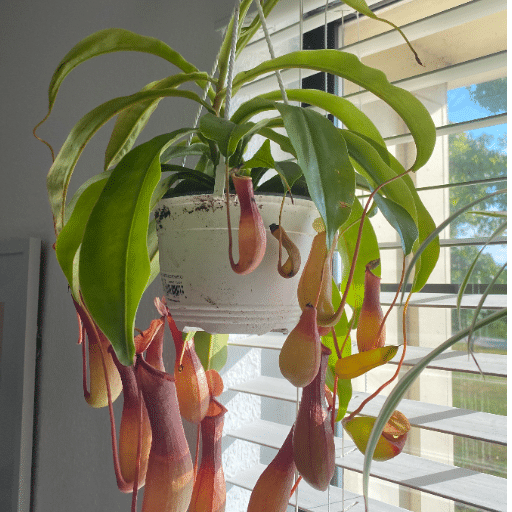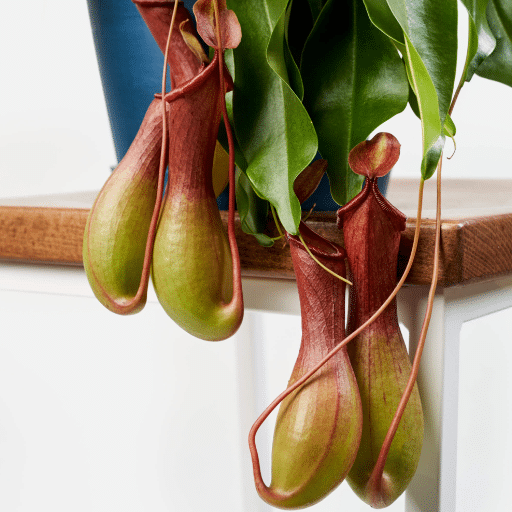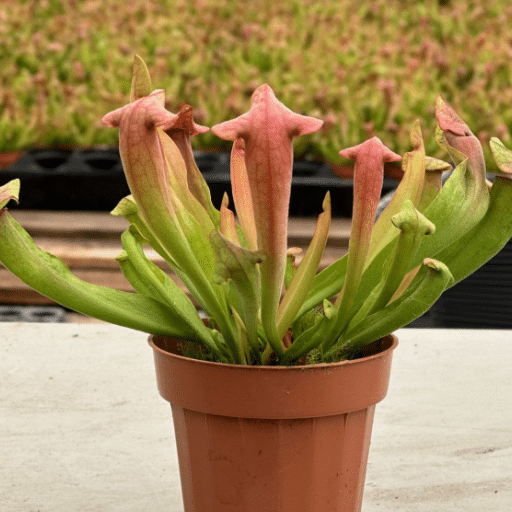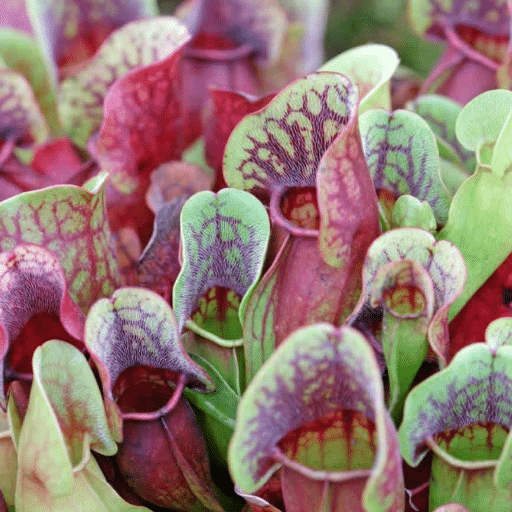Nurturing a pitcher plant is highly rewarding, as it essentially involves caring for a truly erratic and fabulous tropical carnivorous plant. The pitcher plant comes with its exotic looks and is well known for attracting and digesting insects. However, such plants require specific practices in their care, which usually mimic their life in the wild.
This comprehensive guide will provide you with a detailed approach to successful cultivation and all-around care of pitcher plants, covering essential topics including light, water, soil, temperature requirements, and proper feeding habits. Whether you’re a beginner plant enthusiast or an experienced grower, this guide will help you nurture these extraordinary additions to your home or garden.
Types of Pitcher Plants

The variety of pitcher plants ensures that they contain peculiarities that make each a special addition to any plant collection. Understanding the different types will help you choose the right species for your environment and care capabilities.
Main Categories
| Type | Scientific Name | Origin | Climate Preference | Key Features |
|---|---|---|---|---|
| North American Pitcher Plants | Sarracenia | North America | Temperate | Tall, tubular pitchers; bog dwellers |
| Tropical Pitcher Plants | Nepenthes | Southeast Asia | Warm & Humid | Suspended, colorful pitchers; “monkey cups” |
| Cobra Plant | Darlingtonia californica | California/Oregon | Cool, wet conditions | Hooded, cobra-like appearance |
| Sun Pitchers | Heliamphora | South America | Highland tropical | Simple, funnel-shaped pitchers |
American Pitcher Plant Varieties (Sarracenia)
American pitcher plants are found in the Sarracenia genus and are native to North America. These plants thrive in nutrient-poor, wetland environments where they rely on insects for nourishment.
- Sarracenia purpurea (Purple Pitcher Plant): Compact, low-lying pitchers with distinctive purple coloration
- Sarracenia flava (Yellow Pitcher Plant): Tall, trumpet-shaped pitchers with brilliant yellow color
- Sarracenia leucophylla (White-topped Pitcher Plant): Striking white and green coloration with red veining
- Sarracenia rubra (Sweet Pitcher Plant): Smaller, slender pitchers with sweet nectar
Tropical Pitcher Plants Overview (Nepenthes)
Tropical pitcher plants, mainly those of the genus Nepenthes, are captivating carnivorous plants found in Southeast Asia, Madagascar, and parts of Australia. They thrive in hot and humid climates, making them excellent candidates for indoor cultivation under controlled conditions.
Lowland vs Highland Species
| Type | Temperature Range | Humidity Needs | Light Requirements | Popular Species |
|---|---|---|---|---|
| Lowland Species | 75-85°F (24-29°C) | 70-90% | Bright, indirect light | N. rafflesiana, N. ampullaria |
| Highland Species | 65-80°F day / 50-65°F night | 60-80% | Bright light, some direct sun | N. hamata, N. ventricosa |
Unique Features of Each Type
- Lowland Types: Adapted to consistent warmth and high humidity year-round
- Highland Types: Require cooler nighttime temperatures and can handle temperature fluctuations
- Specialized Forms: Some species feature elaborate pitcher shapes and brilliant colors (N. rafflesiana) or distinctive tooth-like structures (N. hamata)
Growing Tips for Pitcher Plants

Growing pitcher plants successfully requires simulating their native habitats to ensure healthy growth. The key is understanding their unique environmental needs and adapting your care routine accordingly.
Optimal Growing Conditions
Essential Requirements Checklist
- ✅ Soil: Nutrient-poor, well-draining mix (sphagnum moss + perlite)
- ✅ Water: Distilled or rainwater only
- ✅ Light: Bright, indirect sunlight
- ✅ Humidity: Above 50% (preferably 60-80%)
- ✅ Temperature: Species-dependent (see table above)
- ✅ Drainage: Excellent drainage to prevent root rot
How to Grow a Pitcher Plant Indoors
- Choose the Right Location:
- Bright spot with indirect morning sunshine
- Avoid harsh afternoon direct sunlight
- Near a south or east-facing window is ideal
- Temperature Control:
- Maintain consistent temperatures between 60-80°F (15-27°C)
- Tropical species prefer warmer ranges
- Highland species need cooler nighttime temperatures
- Humidity Management:
- Use a humidifier or terrarium environment
- Place on pebble trays filled with water
- Mist regularly (but not directly on pitchers)
- Proper Air Circulation:
- Ensure gentle air movement
- Prevent stagnant, humid conditions that promote fungal growth
Watering and Nutrient Needs
| Water Type | Recommended | Notes |
|---|---|---|
| Distilled Water | ✅ Best Choice | Pure, mineral-free option |
| Rainwater | ✅ Excellent | Natural choice, collect when possible |
| Reverse Osmosis Water | ✅ Good | Low mineral content |
| Tap Water | ❌ Never Use | High mineral content harmful to plants |
Watering Schedule and Technique
- Soil Moisture: Keep soil consistently moist but never waterlogged
- Tray Method: During growing season, maintain shallow water in plant tray
- Daily Monitoring: Check soil daily and water when top inch begins to dry
- Drainage: Ensure excellent drainage to prevent root rot
Feeding and Nutrition
Natural Feeding Process
- Plants attract insects with nectar and bright colors
- Insects fall into pitchers and are digested
- Nutrients from prey supplement plant nutrition
- Indoor plants may need occasional feeding assistance
Supplemental Feeding (If Necessary)
- Suitable Insects: Small ants, fruit flies, gnats, dried crickets
- Frequency: 1-2 insects per pitcher per month maximum
- Size: Insects should be no larger than 1/3 the size of the pitcher
- Avoid: Dead insects, meat, or any other food items
Seasonal Care and Dormancy

Understanding Dormancy in Pitcher Plants
Dormancy is a natural and necessary part of the life cycle for temperate pitcher plants, especially Sarracenia species. This rest period is crucial for their health and future growth.
Dormancy Requirements by Type
| Plant Type | Dormancy Required | Duration | Temperature Range |
|---|---|---|---|
| Sarracenia (American) | Yes | 3-4 months | 35-50°F (2-10°C) |
| Nepenthes (Tropical) | No | N/A | Maintain normal temperatures |
| Darlingtonia | Yes | 3-4 months | 32-45°F (0-7°C) |
Winter Dormancy Care Practices
Preparing for Dormancy (Late Fall)
- Temperature Reduction: Gradually move plants to cooler location
- Light Management: Provide bright but cool conditions
- Watering Adjustment: Reduce watering frequency significantly
- Feeding Cessation: Stop all feeding during dormancy period
During Dormancy (Winter)
- Location: Unheated garage, cold frame, or cool window
- Moisture: Keep soil just slightly moist, never dry or soggy
- Monitoring: Check soil every 2-3 weeks
- Protection: Protect from freezing temperatures
Emerging from Dormancy (Spring)
- Gradual Transition: Slowly return to normal temperatures
- Increased Watering: Resume regular watering schedule
- Light Exposure: Gradually increase light levels
New Growth: Watch for signs of new pitcher development
Pruning Techniques for Healthy Growth
Proper pruning maintains plant health, encourages new growth, and prevents disease. Regular maintenance pruning keeps your pitcher plants looking their best and functioning optimally.
When and What to Prune
| Plant Part | When to Prune | Why Prune | Technique |
|---|---|---|---|
| Dead Pitchers | Year-round | Prevent rot, redirect energy | Cut at base of pitcher |
| Brown Leaves | As they appear | Maintain health, prevent disease | Cut at soil level |
| Flower Stalks | After flowering | Conserve plant energy | Cut close to base |
| Damaged Growth | Immediately | Prevent spread of damage | Cut to healthy tissue |
Pruning Best Practices
- Sterilize Tools: Always use clean, sharp scissors or pruners
- Clean Cuts: Make decisive cuts to minimize tissue damage
- Remove Debris: Clean up all pruned material from around plants
- Monitor Results: Watch for new growth after pruning
Repotting Pitcher Plants

When to Repot Your Pitcher Plant
Regular repotting is essential for maintaining healthy pitcher plants. Look for these signs that indicate it’s time to repot:
- Root Bound: Roots growing out of drainage holes
- Soil Deterioration: Old soil becoming compacted or breaking down
- Slow Growth: Plant showing signs of stunted development
- Time Frame: Generally every 1-2 years for most species
Choosing the Right Soil Mix
Recommended Soil Combinations
| Soil Mix | Ratio | Best For | Benefits |
|---|---|---|---|
| Sphagnum Moss + Perlite | 50/50 | Most species | Excellent drainage and moisture retention |
| Peat + Perlite + Sand | 40/30/30 | Sarracenia | Mimics natural bog conditions |
| Orchid Bark + Sphagnum | 60/40 | Nepenthes | Excellent aeration for epiphytic growth |
❌ Avoid These Soils:
- Standard potting soil (too nutrient-rich)
- Garden soil (may contain harmful minerals)
- Miracle-Gro or fertilized soils
- Soils with added lime or pH adjusters
Steps to Successfully Repot
- Preparation:
- Choose a pot slightly larger than the current container
- Ensure pot has adequate drainage holes
- Prepare fresh soil mix
- Sterilize scissors or pruning tools
- Removal:
- Carefully lift plant from the original pot
- Gently shake loose old soil
- Inspect roots for damage or rot
- Root Care:
- Trim any black, mushy, or damaged roots
- Use sterilized scissors for clean cuts
- Leave healthy white or light-colored roots intact
- Replanting:
- Fill new pot halfway with soil mix
- Place plant at same depth as previously planted
- Fill around roots with fresh soil
- Gently firm soil without compacting
- Post-Repotting Care:
- Water thoroughly with distilled water
- Place in warm, humid location
- Provide bright, indirect light
- Monitor closely for first few weeks
Common Issues and Solutions

Even with proper care, pitcher plants can experience problems. Early identification and appropriate treatment are key to maintaining healthy plants.
Troubleshooting Guide
| Problem | Symptoms | Likely Causes | Solutions |
|---|---|---|---|
| Overwatering | Root rot, wilting, musty smell | Poor drainage, excessive watering | Improve drainage, reduce watering frequency |
| Yellowing Leaves | Leaves turn yellow and drop | Watering issues, nutrient problems | Adjust watering schedule, check soil drainage |
| Pest Infestation | Visible insects, webbing, damage | Spider mites, aphids, scale | Insecticidal soap, neem oil treatment |
| Stunted Growth | No new growth, small size | Poor soil, inadequate light | Repot with fresh soil, improve lighting |
| Drooping Leaves | Leaves hang limply | Insufficient light, watering issues | Move to brighter location, adjust watering |
| No Pitcher Formation | Leaves grow but no pitchers | Low light, low humidity, stress | Increase light and humidity, reduce stress |
Pests and Diseases Affecting Carnivorous Plants
Common Pests
- Aphids: Small, soft-bodied insects that cluster on new growth
- Spider Mites: Tiny mites that cause stippling and webbing
- Fungus Gnats: Small flies whose larvae feed on roots
- Scale Insects: Small, hard-shelled insects that attach to stems
Disease Issues
- Root Rot: Caused by overwatering and poor drainage
- Crown Rot: Fungal infection at the plant’s base
- Leaf Spot: Fungal spots on leaves due to poor air circulation
Treatment Options
- Insecticidal Soap: Safe, effective treatment for most pests
- Neem Oil: Natural treatment for pests and some fungal issues
- Improved Cultural Conditions: Better air circulation and drainage
- Physical Removal: Hand-picking larger pests when possible
Signs of Stress in Pitcher Plants
🚨 Immediate Attention Required
- Browning or wilting pitchers
- Yellowing of multiple leaves
- Cessation of new pitcher production
- Visible pest infestations
- Soft, mushy roots or stems
Expert Tips for Recovery
- Create Stable Environment:
- Consistent temperature and humidity
- Proper light levels without stress
- Protected from drafts and temperature swings
- Address Water Quality:
- Ensure only distilled or rainwater is used
- Check soil moisture daily
- Improve drainage if necessary
- Monitor and Treat Pests:
- Regular inspections for early detection
- Immediate treatment with appropriate methods
- Quarantine affected plants if necessary
- Adjust Care Routine:
- Supplement with grow lights if needed
- Increase humidity gradually
- Reduce stress factors in the environment
Reference Sources
-
Martha Stewart: Pitcher Plant Care: How to Grow This Carnivorous Plant – This source discusses the light requirements and outdoor placement for pitcher plants.
-
Tom’s Carnivores: Tropical Pitcher Plants: How to Care for Nepenthes – Offers detailed advice on watering and soil conditions for tropical pitcher plants.
-
New York Botanical Garden (NYBG): Carnivorous Plant Care: American Pitcher Plant – Provides insights on soil moisture and pot placement for American pitcher plants.
Frequently Asked Questions (FAQs)
What are the different types of pitcher plants?
The types of pitcher plants include species like Sarracenia and Nepenthes. Each type has unique characteristics and can thrive in different environments. For example, Sarracenia species are native to North America and prefer full sunlight, while Nepenthes are tropical and often found in greenhouses. Understanding the specific needs of each type will help you grow pitcher plants successfully. Some may require more humidity or specific soil mixtures, such as peat moss mixed with either lime-free horticultural sand or perlite. By selecting the right species for your conditions, you can ensure your plants grow best.
How do I grow pitcher plants indoors?
To grow indoor pitcher plants successfully, ensure they receive at least six hours of direct sunlight each day. A south-facing window is ideal, but if natural light is insufficient, consider using grow lights. These carnivorous plants require a specific soil mixture, typically a mixture of peat moss and orchid bark, to thrive. Maintaining humidity levels is also crucial; you can mist the plants or place them on a tray of water with pebbles. Additionally, keep the soil moist but not soggy. Regularly adding dried crickets or other insects can also help provide the nutrients they need.
How do I care for pitcher plants during winter dormancy?
During winter dormancy, it’s essential to provide your pitcher plants with a cooler environment to mimic their natural habitat. Most species of Sarracenia will thrive in temperatures between 35°F and 50°F. Reduce watering to keep the soil damp but not overly wet; this is crucial as too much moisture can lead to root rot. If you live in an area with harsh winters, consider bringing outdoor pitcher plants inside or providing them with frost protection. This dormancy period is vital for their growth cycle, allowing them to conserve energy for the upcoming growing season. After the dormancy period, gradually reintroduce them to warmer temperatures and more light.
How often should I repot pitcher plants?
Repotting pitcher plants is generally recommended every 1 to 2 years, especially if you notice their growth slowing down or the soil becoming compacted. When repotting, use a fresh mixture of peat moss mixed with either lime-free horticultural sand or perlite to ensure proper drainage and aeration. It’s best to do this during the spring when the plants are actively growing. Be gentle when handling the roots to avoid damage, as they can be quite delicate. Repotting not only refreshes the soil but also gives the plants room to grow and thrive. If your plants are young, they may need repotting more frequently than adult plants.
How do I prune a pitcher plant?
Pruning pitcher plants is essential for maintaining their health and encouraging new growth. You can prune away any dead or damaged leaves at the base to promote better airflow and prevent disease. Additionally, removing older pitchers that have turned brown can help the plant focus its energy on new growth. When pruning, use clean, sharp scissors to make a clean cut and reduce the risk of infection. Regular pruning not only helps maintain the plant’s aesthetic appeal but also encourages the production of more vibrant and functional pitchers. This practice is particularly beneficial during the growing season when the plant is actively producing new leaves.
What do pitcher plants require to thrive?
Pitcher plants require specific conditions to thrive, including a soil mixture that retains moisture while providing good drainage. A mixture of peat moss and orchid bark is ideal. They also need access to full sunlight; ideally, they should receive at least six hours of direct sunlight daily. Additionally, pitcher plants are carnivorous and benefit from a diet that includes insects like crickets. You can supplement their nutrition by providing dried crickets or similar food. Furthermore, using reverse osmosis water or distilled water is recommended, as these plants do not tolerate high mineral content. Keeping the soil damp at all times while avoiding waterlogging is key to their success.






